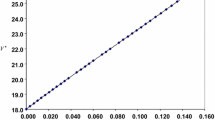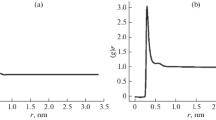Summary.
From the density of solutions of water in 1-hexanol, 1-octanol, 1-decanol, and cyclohexanol, measured at 298.15 K, the limiting partial molar volume and the excess limiting partial molar volume of water was estimated. The limiting partial molar volume of water in alcohols was discussed in terms of the void space created by the addition of water to alcohol and by the packing density of water. On the basis of the Kirkwood-Buff theory and the activity of water in alcohols an average aggregation number of water molecules, as well as the number of the excess alcohol molecules in the surroundings of the water molecule was calculated. The solvation ability of the investigated alcohols was estimated as the difference in the solvation Gibbs energy of an alcohol molecule in solution relative to the pure alcohol. The observed difference was mainly ascribed to an indirect effect caused by water molecules on the alcohol structure and to a lesser extent to the hydrogen bonding of water to alcohol molecules. The limiting partial molar volume of water was also interpreted in terms of scaled particle theory and the various volume contributions arising from dispersion, dipole–dipole, and inductive interactions between water and an alcohol molecule were calculated.
Similar content being viewed by others
Author information
Authors and Affiliations
Corresponding author
Rights and permissions
About this article
Cite this article
Šegatin, N., Klofutar, C. Limiting Partial Molar Volumes of Water in 1-Hexanol, 1-Octanol, 1-Decanol, and Cyclohexanol at 298.15 K. Monatshefte für Chemie 135, 161–172 (2004). https://doi.org/10.1007/s00706-003-0121-2
Received:
Accepted:
Published:
Issue Date:
DOI: https://doi.org/10.1007/s00706-003-0121-2




